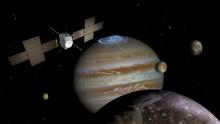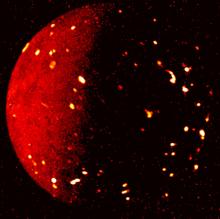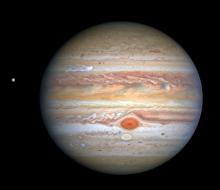Listen to today's episode of StarDate on the web the same day it airs in high-quality streaming audio without any extra ads or announcements. Choose a $8 one-month pass, or listen every day for a year for just $30.
You are here
Moon and Jupiter
Io is the most active body in the solar system — hundreds of volcanoes make its surface look like a scarred apricot. It also has some of the tallest mountains in the solar system — but they’re not volcanoes. Yet the mountains and volcanoes are formed by related processes.
Io is one of the big moons of Jupiter. It’s at the middle of a tug-of-war between Jupiter and some of its other big moons. That battle squeezes and pulls Io’s interior, making it extremely hot. In fact, an “ocean” of molten rock may lie below its crust.
Some of the molten rock pushes its way to the surface, forming volcanoes. Some of them erupt almost non-stop. Others stage outbursts that can last for weeks. An outburst can coat many square miles with lava that sizzles at more than 2,000 degrees Fahrenheit. In all, the volcanoes produce enough lava to cover the entire moon with a layer a centimeter thick every year.
The volcanoes are all pretty low. But some of Io’s non-volcanic mountains are miles high. They form as parts of the crust are pushed upward. They may be shoved by hot rock that’s working its way upward; by slabs of old crust that are plunging below newer crust, or by a similar mechanism — giving Io some of the most active mountains in the solar system.
Look for Jupiter close above the Moon at dawn tomorrow. It looks like a brilliant star. Through binoculars, Io and Jupiter’s other big moons look like small stars quite near the planet.
Script by Damond Benningfield






